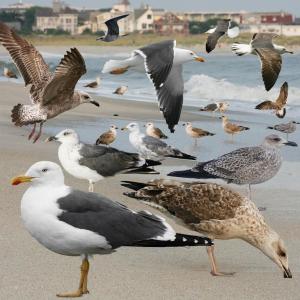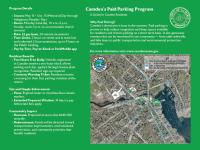Five Things We Love About Birding in September
 Once rare in Maine, lesser black-backed gulls have become more frequent, likely due to an increasing number that nest in Greenland. Image courtesy of Crossly ID Guide to Eastern Birds, Wiki media Commons
Once rare in Maine, lesser black-backed gulls have become more frequent, likely due to an increasing number that nest in Greenland. Image courtesy of Crossly ID Guide to Eastern Birds, Wiki media Commons
 Birders flock to Monhegan Island in September, since the island is a magnet for migrating birds including rarities from the western U.S. Courtesy of Jeff Wells
Birders flock to Monhegan Island in September, since the island is a magnet for migrating birds including rarities from the western U.S. Courtesy of Jeff Wells
 Once rare in Maine, lesser black-backed gulls have become more frequent, likely due to an increasing number that nest in Greenland. Image courtesy of Crossly ID Guide to Eastern Birds, Wiki media Commons
Once rare in Maine, lesser black-backed gulls have become more frequent, likely due to an increasing number that nest in Greenland. Image courtesy of Crossly ID Guide to Eastern Birds, Wiki media Commons
 Birders flock to Monhegan Island in September, since the island is a magnet for migrating birds including rarities from the western U.S. Courtesy of Jeff Wells
Birders flock to Monhegan Island in September, since the island is a magnet for migrating birds including rarities from the western U.S. Courtesy of Jeff Wells
1. The Weather – How can you not love the weather of September in Maine? Mornings start crisp and fresh with dew on the grass as you watch for warblers in the shrubbery. By afternoon, you’re comfortable in a t-shirt as you scan the incredibly blue skies for raptors. As evening comes, the coolness returns along with the golden sunlight as you watch for nighthawks swooping over the treetops in search of insects.
2. Lesser Black-backed Gulls – These smaller, yellow-legged cousins of the common great black-back gull, which breeds on Maine islands, reach their peak abundance in Maine in September. This population of lesser black-backed gulls nest in Greenland and migrate through Maine on their way to the Mid-Atlantic states for the winter. They were formerly very rare in Maine at all seasons, but as the Greenland breeding population has increased, they have become more regular. Still, the largest numbers of them pass through the state in September.
3. Hawk Watching – September (and October) are peak times for fall hawk migration across the northeastern U.S. including here in Maine. We’re not sure how many places have official hawk watches these days, but there seems to be good coverage over at Cadillac Mountain in Acadia National Park, sometimes at Clarry Hill in Union, and on Mount Agamenticus down in southern Maine. Any high place with a view or coastal peninsula or island can be great for watching for migrating hawks, especially on days with winds blowing from the North. There’s nothing as thrilling or addictive (in a good birding way) as scanning the skies to wonder what hawk might be coming next—will it be a rapidly beating little sharp-shinned hawk or a swift-winged merlin. Maybe it will be an entire kettle (flock) of broad-winged hawks streaming toward you after riding a rising thermal in the distance.
4. Watching for Westerns – September is an especially good time to watch for a number of rarer species that nest in the western U.S. but show up in Maine in the fall. Coastal locations are especially good places to watch out for some of these birds. Monhegan Island is probably the most famous place where these types of unusual birds are detected every year. That may be partly because there are so many birders each fall scouring every bird from dawn to dusk on this small island. More likely, it’s because the island’s offshore location means that any bird migrating high in the sky looking for a place to stop and rest from many miles around recognizes it could be a last opportunity and drops in for a visit. Birds like dickcissels, lark sparrows, and blue grosbeaks are among the species that birders have been finding at scattered locations around the state (including Monhegan) over the last week or so.
5. An Abundance of Challenges – By September, the bulk of warblers, sandpipers, and other birds passing through are often made up of young birds hatched just a few months ago somewhere far to the north. Adults typically migrate through earlier, leaving the young of the year to find their own way south using whatever has been imprinted through evolution into their brains. Sometimes these young birds can be a tad more challenging to identify than the brightly colored spring adult birds. And that’s the fun part!
In fact, it’s all the fun part!
Jeffrey V. Wells, Ph.D., is a Fellow of the Cornell Lab of Ornithology and Vice President of Boreal Conservation for National Audubon. Dr. Wells is one of the nation's leading bird experts and conservation biologists. He is a coauthor of the seminal “Birds of Maine” book and author of the “Birder’s Conservation Handbook.” His grandfather, the late John Chase, was a columnist for the Boothbay Register for many years. Allison Childs Wells, formerly of the Cornell Lab of Ornithology, is a senior director at the Natural Resources Council of Maine, a nonprofit membership organization working statewide to protect the nature of Maine. Both are widely published natural history writers and are the authors of the popular books, “Maine’s Favorite Birds” (Down East Books) and “Birds of Aruba, Bonaire, and Curaçao: A Site and Field Guide,” (Cornell University Press).

























